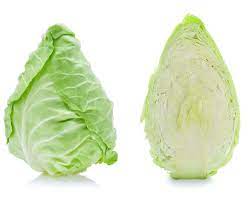Conehead cabbage
« previous post | next post »
A new kind of cabbage for me:

I encountered this strange vegetable at Martindale's, the nation's first health food store (established in 1869), which is about a mile from my home. They often have rare, exotic fruits and vegetables that I've never seen anywhere else.
It was in the evening, so there was only a skeleton crew of about 4 or 5 staff members. As I was checking out, the woman at the counter asked me what kind of cabbage this was — she herself had never seen its likes before. She didn't have a product code number for it. If she didn't know what to call this kind of cabbage, she wouldn't know what to charge me for it. After a while, she said, "I think it's Napa".
I replied, "No, it's not Napa cabbage. I know what Napa cabbage is like. I buy it all the time".
Whereupon she declared, "Maybe it's just deformed regular cabbage. We could call it 'deformed cabbage'".
After consulting with several other persons in the store, all of whom were stumped and stymied by the curious cabbage before us.
"I think we should call it 'conehead cabbage'", I declared, and everybody laughed. I had never seen such a cabbage and never heard anyone use that expression.
When I got home, I looked up "conehead cabbage" and discovered that people have been calling it that for years. Apparently it is also called "pointed (white) cabbage", "sweetheart cabbage", "arrowhead cabbage", and other creative, whimsical names.

Coneheads: Music from the Motion Picture
Archeologically speaking, we do from time to time come upon deformed skulls like this:

The main lessons I learned from this encounter with a strange type of cabbage at Martindale's Natural Market on Tuesday, August 16, 2022:
- Naming things is subject to all sorts of variables.
- Different people can spontaneously come up with the same names.
- A name can be playful, arbitrary, serious, scientific, and so on.
- There's nothing essentially intrinsic about a name.
Selected readings
- "Really?!" (12/27/16) — clementine / mandarin / etc. oranges
- "Napa cabbage" (1/16/21)
- "Kimchee" (1/2/14)
- "What's this pickled cabbage?" (5/25/12)
- "The shrimp did what to the cabbage?" (9/11/06)
- "Spinach: the Persian vegetable" (1/19/21)
Irina said,
August 20, 2022 @ 1:00 am
Dutch: spitskool. It's a pointy (not deformed, it grows like that) variety of white cabbage, Brassica oleracea convar. capitata var. alba. Very common in the Netherlands. It's softer and less dense than ordinary white cabbage and available all year round. It's one of the least exotic things we have here, so it was an eye-opener that people on the other side of the world would call it exotic!
Asuitablecase said,
August 20, 2022 @ 2:07 am
In my local supermarket (UK) they’re called hispi cabbages.
Helmut Kohl said,
August 20, 2022 @ 2:48 am
German: Spitzkohl (analogous to Dutch), “pointed cabbage”, and very much not exotic.
Mojones said,
August 20, 2022 @ 3:57 am
Very common in the UK. Usually sold as hispi or sweetheart. Makes excellent coleslaw. I have one on my counter that Ibought just for that purpose.
Cheryl Thornett said,
August 20, 2022 @ 5:00 am
Yes, it's very common in the UK, and I choose it in preference to round white (cannonball) cabbages. I've only seen it called sweetheart or pointed cabbage.
Philip Taylor said,
August 20, 2022 @ 5:00 am
"Hispi" is unattested in the online OED, and nowhere can I find an etymology. Can anyone help ?
V said,
August 20, 2022 @ 5:38 am
Irina: This reminds me of the latest xkcd, https://xkcd.com/2660/
> Curdled milk, of a peculiar kind, made after a Bulgarian recipe and called "yaghurt," is now a Parisian fad and is believed to be a remedy against growing old. A correspondent who has tried it, says he would prefer to die young. (1905, The Elk Falls Journal)
Here in Bulgaria "living on bread and yoghurt" is an expression that means "dirt poor".
V said,
August 20, 2022 @ 6:33 am
When I see people from cultures where yoghurt is not a basic food staple commenting on it being "fadish" it's always amusing.
Pedro Silva said,
August 20, 2022 @ 6:53 am
Portuguese: "couve-coração" (heart-cabbage), and as common as a cabbage can be :-)
Victor Mair said,
August 20, 2022 @ 8:14 am
@Helmut Kohl
Every time you write or speak your surname, do you think of that group of cruciferous vegetables we're discussing?
Rosemary Kuwahata said,
August 20, 2022 @ 8:53 pm
In Australia it is called "sugarloaf cabbage" and is generally available all year round.
Adam said,
August 21, 2022 @ 3:26 am
Sold as "chou pointu" here in Brussels. It's ubiquitous and is not remotely exotic but the heads are quite light so it works out rather pricier per kilo than regular white cabbage (chou blanc).
Nhan Hong said,
August 21, 2022 @ 11:44 am
I would call it Miss Vietnam cabbage.
Laura said,
August 22, 2022 @ 7:32 am
I’m guessing that cabbage might be Early Jersey Wakefield, which is listed in several of my regular seed catalogs (e.g., https://www.rareseeds.com/early-jersey-wakefield-cabbage) and which I attempted myself this summer with middling success.
László said,
August 22, 2022 @ 9:34 am
Here in Denmark, it's pretty much ubiquitous, called 'spidskål' (pointed cabbage, just like in Dutch and German). In the "official" Danish Dictionary (https://ordnet.dk/ddo/ordbog?query=spidskål), the example sentence using the word is from 1985. With older spelling (spidskaal), the word is also present in a 1943 dictionary (https://ordnet.dk/ods/ordbog?query=spidskaal). So it seems not to be that new around these parts of the world.
An otherwise kale-focused article on the Danish Broadcasting Corporation's site (https://www.dr.dk/levnu/mad/madhistoriker-groenkaal-er-danmarks-vigtigste-groentsag) remarks that this variety of white cabbage was introduced into Danish cuisine "between 1850 and 1950".
The most accurate scientific name seems to be 'brassica oleracea var. capitata for. alba subv. conica'. Some research on that might yield an actual date and point of origin for the obsessively interested.
For what it's worth, I was born in central Transylvania (Romania), and first encountered this brassica after moving to Denmark at 30. So it's not like it's a staple crop in Europe.
MarkB said,
August 22, 2022 @ 11:35 am
I've seen it available in seed catalogues. There are varieties of cabbage that are meant to be harvested at a relatively small head size – this is one. Good for home gardens where space is at a premium.
Monscampus said,
August 22, 2022 @ 8:20 pm
@Victor Mair
Re: Helmut Kohl
No idea if that's his real name, though it fits this context well. It not only means cabbage, but also nonsense. The other Helmut (Schmidt) once rudely interrupted him, "Stop talking such *Kohl*!" There's also a verb, verkohlen (to swindle). Kohl's nick was *Birne* (pear – because of his pear-shaped face).
Bob Moore said,
August 22, 2022 @ 9:32 pm
"Sweetheart cabbage" is called for in my favorite Chinese cookbook, "The Food of Sichuan" by Fuchsia Dunlop, but I have never been able to find it in any grocery store, Asian or otherwise.
Jamie said,
August 23, 2022 @ 6:52 am
It is described here: https://www.rhs.org.uk/plants/107315/brassica-oleracea-(capitata-group)-hispi/details
No explanation of the etymology of the name. I assume not from Latin "hispid" (hairy). Presumably, as a hybrid, it was named by person who created it.
Liz said,
August 26, 2022 @ 2:26 pm
Greyhound cabbage. Tenderer than the Dutch cabbage (the white, round one).
Greyhound seems to be the more common name in Ireland, although I see there's a variety called that in the Thompson Morgan catalogue in the UK.